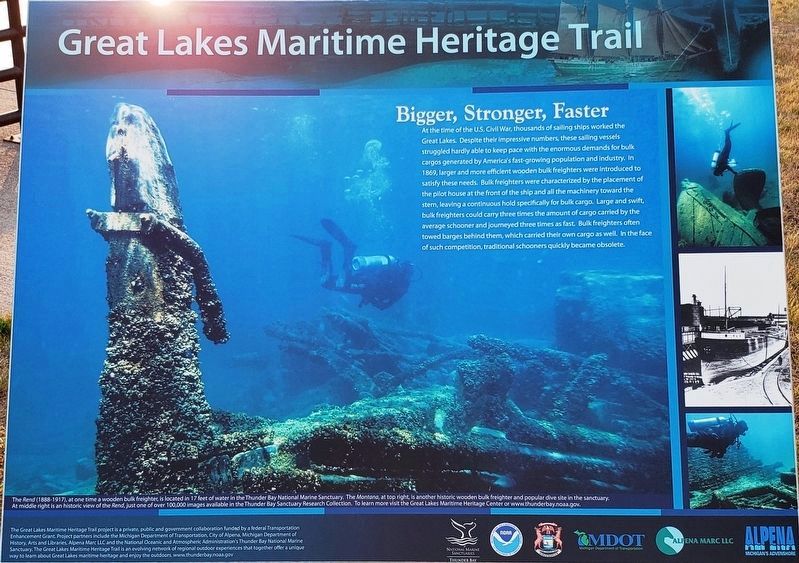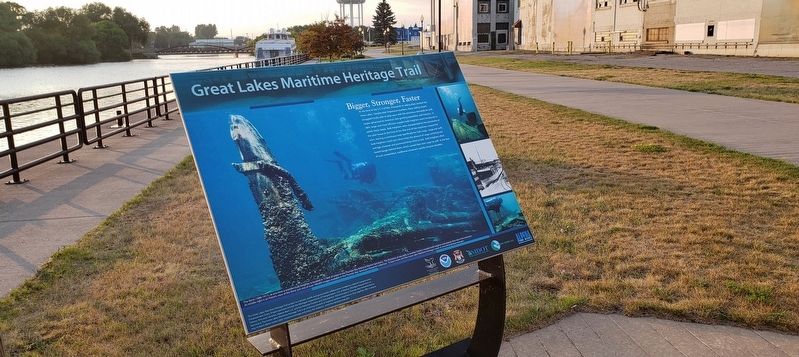Alpena in Alpena County, Michigan — The American Midwest (Great Lakes)
Bigger, Stronger, Faster
Inscription.
At the time of the U.S. Civil War, thousands of sailing ships worked the Great Lakes. Despite their impressive numbers, these sailing vessels struggled hardly able to keep pace with the enormous demands for bulk cargos generated by America's fast-growing population and industry. In 1869, larger and more efficient wooden bulk freighters were introduced to satisfy these needs. Bulk freighters were characterized by the placement of the pilot house at the front of the ship and all the machinery toward the stern, leaving a continuous hold specifically for bulk cargo. Large and swift, bulk freighters could carry three times the amount of cargo carried by the average schooner and journeyed three times as fast. Bulk freighters often towed barges behind them, which carried their own cargo as well. In the face of such competition, traditional schooners quickly became obsolete.
Erected by Great Lakes Maritime Heritage Trail.
Topics. This historical marker is listed in these topic lists: Industry & Commerce • Waterways & Vessels.
Location. 45° 3.991′ N, 83° 26.036′ W. Marker is in Alpena, Michigan, in Alpena County. Marker can be reached from West Fletcher Street west of Commercial Street, on the left when traveling north. Marker is located along the Alpena Bi-Path, on the west side of the U.S. Fish & Wildlife complex, beside the Thunder Bay River. Touch for map. Marker is at or near this postal address: 480 West Fletcher Street, Alpena MI 49707, United States of America. Touch for directions.
Other nearby markers. At least 8 other markers are within walking distance of this marker. A Shipbuilding Revolution (here, next to this marker); Fast Steel Flyer: The Bulk Freighter Grecian (within shouting distance of this marker); Steaming Open the Frontier (about 300 feet away, measured in a direct line); Research Vessels (about 400 feet away); Rising from the Ashes: The New Orleans (about 400 feet away); The Fletcher Coal Piers (about 500 feet away); Propellers (about 500 feet away); The Loss of the Pewabic (about 500 feet away). Touch for a list and map of all markers in Alpena.
More about this marker. Marker is a large composite plaque, mounted waist-high on a metal supporting rack.
Also see . . . Bulk Freight Steamers. Captain Elihu M. Peck designed a variant of the steambarge in 1869 to meet the requirements of the iron ore and grain trades. Peck designed a double-decked vessel with plenty of space below decks for dry bulk cargo, fitted with wide deck hatches evenly spaced to match the 24-foot spacing of the loading chutes at Marquette's ore docks. His vessel had a capacity for 1,200 tons of ore and enough power to tow one or two loaded barges. The result was the 210-foot "bulk freighter," Robert J. Hackett. Most bulk freighters had three or four tall masts. They carried sails until around 1890. Bulk freighters were profitable because they carried large quantities of bulk commodities economically. Few bulk freighters measured less than 200 feet in length. (Submitted on August 25, 2018, by Cosmos Mariner of Cape Canaveral, Florida.)
Credits. This page was last revised on November 24, 2020. It was originally submitted on August 21, 2018, by Cosmos Mariner of Cape Canaveral, Florida. This page has been viewed 138 times since then and 9 times this year. Photos: 1, 2, 3. submitted on August 25, 2018, by Cosmos Mariner of Cape Canaveral, Florida. • Andrew Ruppenstein was the editor who published this page.


